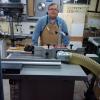I have the Grizzly G0441 and I'd probably buy it again after a head to head comparison with the Oneida's Gorilla line. I'm not sold on spending that kind of money an a plastic kit. Not sure if its still there but at one point Oneida had a list of criticisms of Grizzly cyclones. On mine, it appeared that Grizzly took that as constructive criticism and addressed the issues.




 Reply With Quote
Reply With Quote








